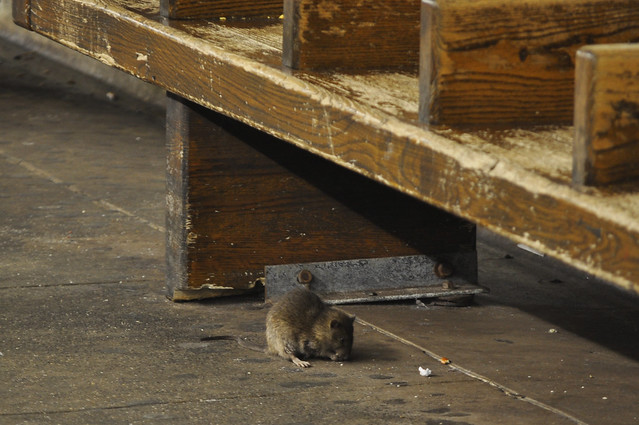
One state senator thinks rats in the subway could become less of a problem if eating were to be outlawed. (Photo by flickr user Ludovic Burtron)
As I sit here stuffed on turkey, food is on the mind. I ate a lot of it tonight and then brought some back to Brooklyn on the subway. Along the way, I didn’t see anyone eating on the train, but I often do. Chicken fingers, sandwiches, muffins — you name it, and people eat it. That, however, might end if State Senator Bill Perkins has his way.
These days, Perkins is fighting an uphill battle against a familiar New York scourge. He wants to combat the rat, a rodent so prevalent in New York City that one author has written an award-winning book about them. They survive everywhere and love the subways for the free food.
Earlier this month, Perkins’ office released a report that highlights the rat problem in the subway. In an unscientific survey, Perkins determined that rat sightings are a major problem. Over 57 percent of respondents said they saw rats in the subway on a daily basis, and nearly everyone pointed food and litter in the subways as the major cause of infestations.
Transit, meanwhile, knows it has a problem. As Thomas Prendergast said at last week’s NYCT Rider’s Council President’s Forum, the subways are filled with trash. MTA workers remove garbage every day from the system, and still, people drop food in subway cars and discard wrappers into the tracks. “Customers don’t like to hear that they’re part of the problem,” Prendergast said, “but we pull out 90 tons of trash a day from the subways.”
Now, Perkins has an idea to combat the rats. He wants to ban food in the subways all together. “Rats don’t grow the food that they eat on the subway, and they don’t buy it, either,” Perkins said to NY1 this week. “We as customers, unfortunately, are the ones that are feeding, and thereby breeding the rodent infestation problem we have.”
Perkins wants the MTA and its contractors to better bait the subways. While Transit has sealed off garbage collection rooms and drainage pipes, these areas are not continually baited. The authority is exploring more agressive rodent control measures, but as cleaners are eliminated and stations get dirty, the agency is facing an uphill task. To that end and for the sake of public health, Perkins thinks draconian measures are in order. “We recommend to them what we know is taking place in other places, like Washington, DC, other countries, where food is outlawed on the public transportation system,” he said.
Perkins, who is now trying to convince straphangers to sign onto this idea, isn’t the first to propose a food ban in the subways, and he want be the last. Forces though conspire against him. New Yorkers rushed for time believe they should be able to nosh on breakfast or lunch in the trains, and the MTA earns a small but steady income from newstands that sell food underground. They couldn’t outlaw eating in the system while maintaining these stands.
Personally, I don’t find eating in the subway that sanitarily appealing in the first place, but I doubt it’s going anywhere. So as long straphangers litter and treat the subway floors with no respect, the rats persist, just as they always have.











